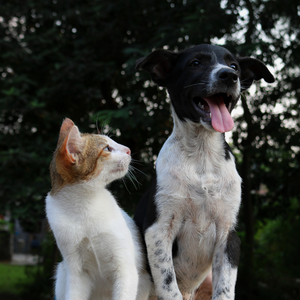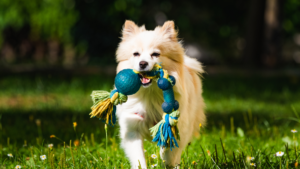As a loving pet owner, whether you own a dog, cat, lizard, hamster, horse, or parrot, you want your animals to be happy. During National Pet Month, we celebrate all of the benefits and joy that pets bring to our lives. It is also an ideal time to consider ways that we can add to their well-being.
Our pets enhance our lives in countless ways. They provide us with unconditional love, companionship, entertainment, and laughter. They can also reduce stress, encourage us to exercise, and even improve our moods. It’s only fair that we bring them happiness, as well.
What is happiness for a pet?
We all seek to understand our pets more deeply, including their needs, behaviors, and what brings them joy. Naturally, we tend to assume that what makes them happy is similar to what makes us happy, and it is difficult to shift our perspective to that of our pets.
One way to understand the difference between our point of view and our pets is to imagine that you and a friend are standing on opposite sides of a room. The two of you may be looking at the same scene, but because you are seeing it from a different angle, it appears completely different.
To make our pets happy, we need to look at the world and how they experience it through their eyes. For example, if you have a spacious fenced yard where you allow your dog to roam, you may view it as a lovely place for your canine to play while keeping them safe. But your dog might see that fence as a barrier, limiting their ability to explore the outside world.
Trying to understand how a situation might feel to our pets allows us to enhance their wants, needs, and desires.
Our pets are constrained by human boundaries because we make all of their life decisions for them, from what they eat to who their friends are. So how can we enrich our pets’ lives? Give them choices!
Here are six ways we can provide our pets with a greater sense of autonomy:
1. The choice to be petted (or not!)
You may think it’s an ideal time to pet and snuggle your cat, but he may have other ideas. If you put your cat in your lap and they struggle and immediately leap down, it’s a sure sign that it’s not an ideal tie for physical bonding. Don’t force the issue! Let him walk away.
2. Choosing where to walk
Dogs love to follow their noses. If possible, allow your dog to choose the route s/he follows for her walk. This allows exploration of new places and smells.
3. A choice to retreat to a safe place
Like humans, every animal is different and has fears and desires. Your dog who is terrified of thunderstorms or fireworks may choose to retreat to an enclosed space, such as a bathroom when the noise gets to be too much. If he’s safe, don’t coax him out. Allow him to stay where he feels secure and protected.
4. Deciding where to sleep
As much as your daughter would love to have your dog sleep in her room, your pup may feel more comfortable sleeping in your room. Many dogs prefer to sleep with whoever they perceive to be the leader of their pack – and that’s often an adult. Don’t force the issue if she chooses to sleep in your room rather than your daughter’s.
5. Choosing to train (or not!)
If your parrot is being especially uncooperative, exhibiting aggressive behavior, or acting disinterested during training, take a break. Don’t push them! Let him retreat to his cage. If he is refusing to participate, it is a sure sign that this is not a good time to teach him to perch on your shoulder.
6. Choosing favorite foods
When it comes to feeding, one way to provide your pet with choices is by separating ingredients. For example, for a dog, you could split its different types of food into individual bowls. Which one does he choose more often? This will tell you what he prefers. If possible, you can alter his diet to include more of his favorites.
Ask your pets!
Are you struggling to figure out what makes your pet happy? I can use telepathic animal communication to help you understand your pet through their eyes, including what makes them happy. Want to learn more? Schedule a consultation.



